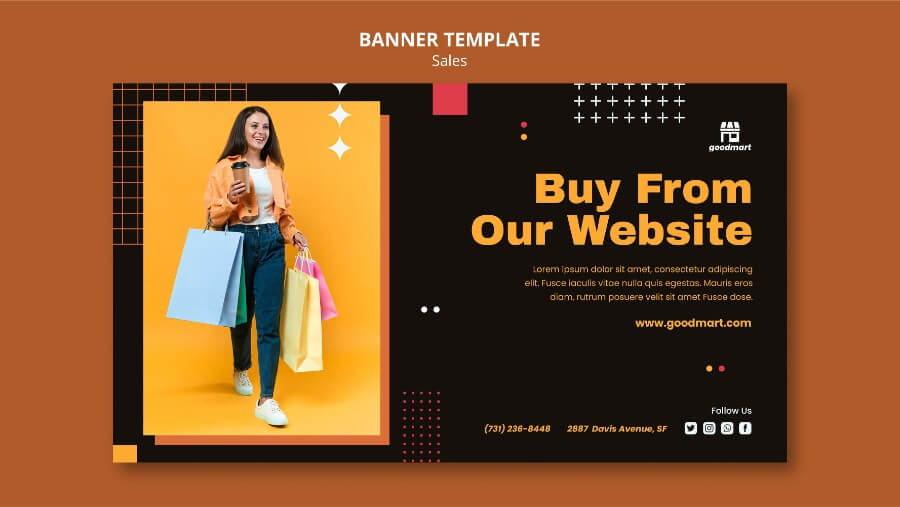
In the bustling digital marketplace, e-commerce banners are not just visual elements; they are strategic instruments crafted to navigate user behavior towards conversion. This comprehensive guide explores the multifaceted approach to creating ad banners that don’t just catch the eye but actively convert visitors into loyal customers.
The Strategic Importance of Banners in E-commerce
Banners function as the digital storefront’s most dynamic billboards, offering a versatile platform to communicate key messages, highlight offers, feature product ads and guide visitors towards making a purchase. Their role extends beyond mere decoration to becoming essential drivers of user engagement and conversion. Effective banners can:
- Grab Attention: With the right mix of visuals and text, they make a compelling first impression.
- Highlight Promotions: They’re an excellent way to showcase special deals, seasonal offers, or exclusive products.
- Navigate the User Journey: Banners can direct users to explore further, whether to new collections, product categories, or informational content.
- Improve User Experience: Seamlessly integrated banners enhance the aesthetic and functional appeal of the site.
Expanding on the Role and Impact
Understanding the nuanced role of banners involves recognizing their capacity to shape the shopping experience. They act as signposts, guiding the user’s journey from interest to decision-making. In the split seconds that a visitor decides to stay or leave, a well-crafted banner can make all the difference.
Crafting Banners That Convert
1. The Power of Clear Messaging
A banner’s message should be unmistakable, direct, and tailored to the target audience. Achieving clarity involves using language that speaks directly to the user’s needs, desires, or pain points. Incorporate action verbs and succinctly present the value proposition to make the message unmissable.
Enhancing Message Clarity
To refine messaging:
- Use bullet points or short lists to break down offers or benefits.
- Include numbers or statistics to highlight the value (e.g., “Save up to 50% off”).
- Test different phrasing to see what resonates best with your audience.
2. Leveraging Color and Contrast
Colors not only capture attention but also evoke emotions and associations. The choice of colors should align with the brand’s identity and the psychological impact intended. Utilizing professional product image editing services can ensure that your colors are accurately represented and visually appealing. Contrast is equally vital, ensuring that text stands out against the background, making it readable at a glance.
Maximizing Impact with Color
To optimize color use:
- Understand color psychology to match the banner’s tone with the desired user emotion.
- Use brand colors for consistency but don’t shy away from bold contrasts to highlight key areas like CTAs. Explore online guides on the best Shopify color schemes for inspiration in creating visually compelling designs that resonate with your audience.
3. Incorporating Effective Imagery
Images can convey a narrative, showcase products in action, or evoke lifestyle aspirations associated with the product. High-resolution, contextually relevant images that align with the message amplify the banner’s impact.
Strategies for Imagery
When selecting images:
- Choose visuals that reflect the target demographic’s aspirations or lifestyle.
- Consider using real-life scenarios that product or offer could fit into, making the value proposition more relatable.
4. Optimizing Strategic Placement
Banner placement should be deliberate, aiming to capture attention without disrupting the browsing experience. Analyze site traffic and user behavior to identify hotspots where banners can be most effective.
Placement Insights
Effective locations often include:
- The site’s landing page, for immediate engagement.
- Key category pages, to direct traffic to high-margin or priority products.
- The checkout page, to introduce last-minute deals or related product suggestions.
5. Designing a Compelling Call-to-Action (CTA)
A banner’s CTA is the critical link between interest and action. It should be visually distinct and contextually integrated into the banner design, offering a clear next step for the user.
Crafting Effective CTAs
To make CTAs more effective:
- Use action-oriented language that conveys urgency or benefit (e.g., “Buy Now to Save!” or “Limited Offer”).
- Experiment with button shapes, sizes, and colors to find the most engaging combination.
6. Personalization and Targeting
Customizing banners based on user data or browsing history can dramatically increase their relevance and effectiveness. Tailored messages and offers can significantly enhance engagement and conversion rates by speaking directly to the individual’s preferences or needs.
Personalization Tactics
Effective personalization involves:
- Segmenting your audience based on behavior, demographics, or purchase history.
- Dynamically changing banner content to match user profiles or past interactions.
7. Embracing Testing and Optimization
Continuous improvement through A/B software testing services, performance analysis, and benchmark testing is key to refining banner strategies. Experiment with different elements to understand what drives user engagement and conversions.
Optimization Practices
For ongoing optimization:
- Regularly rotate banners to prevent ad fatigue.
- Use analytics to track performance metrics and user interaction patterns.
8. Ensuring Responsive Design
With the prevalence of mobile shopping, banners must be designed to adapt seamlessly across devices. Responsive designs not only ensure that banners retain their visual appeal but also help keep mobile checkout optimized, providing users with a smooth and efficient transaction experience on any device.
Responsive Design Considerations
Key aspects include:
- Testing banner layouts across different screen sizes.
- Ensuring that text remains legible and CTAs are clickable on smaller screens.
Conclusion: The Art and Science of Banner Design
Designing banners that convert is both an art and a science, requiring a blend of creativity, strategic thinking, and data-driven insights for e-commerce. By focusing on clear messaging, compelling visuals, strategic placement, and a strong call-to-action, you can create banners that not only attract attention but also drive meaningful engagement and conversions. Remember, the effectiveness of banners lies in their ability to resonate with the audience and enhance the shopping experience. Through continuous testing, personalization, and optimization, your banners can become powerful tools in achieving e-commerce success.